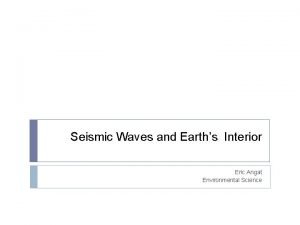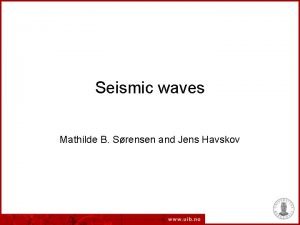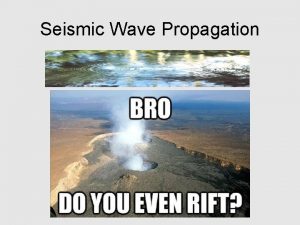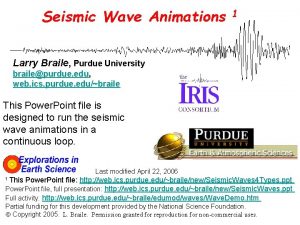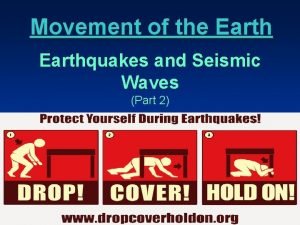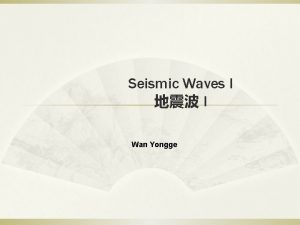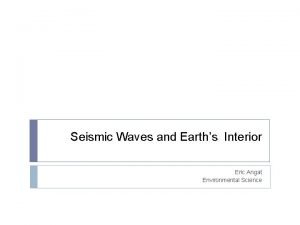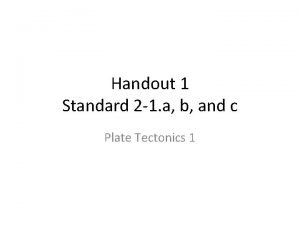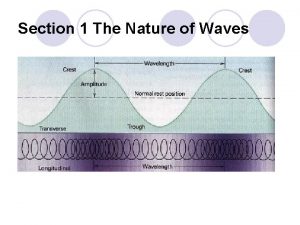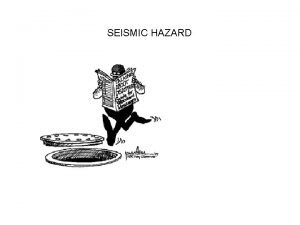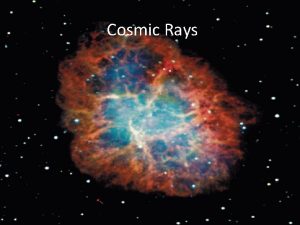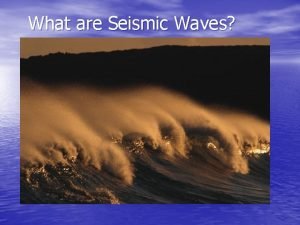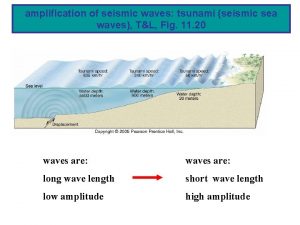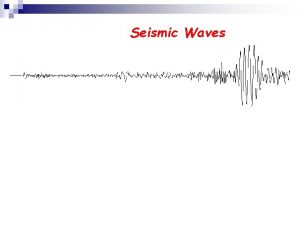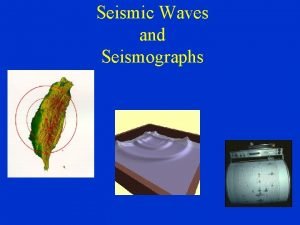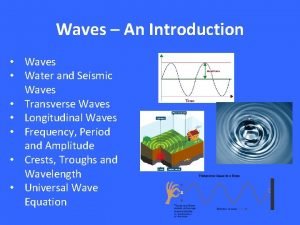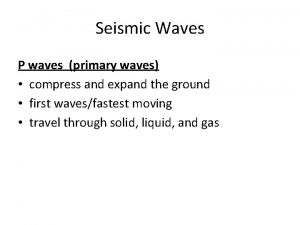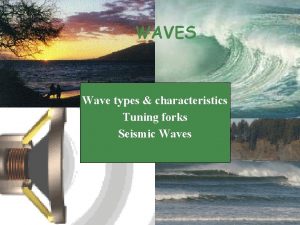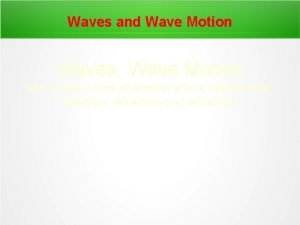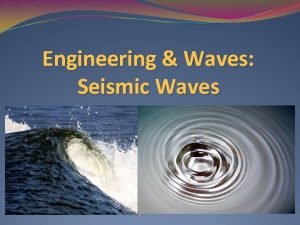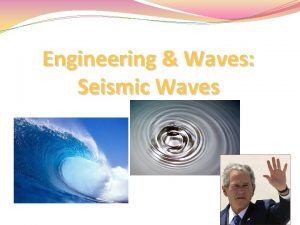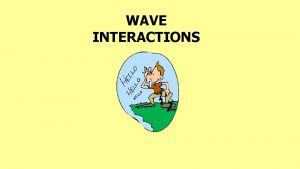Seismic waves and seismic rays A wave front























- Slides: 23

Seismic waves and seismic rays A wave front is a surface connecting all points of equal travel time from the source. Rays are normal to the wavefront, and they point in the direction of wave propagation. While the mathematical description of the wavefronts is rather complex, that of the rays is simple. For many applications is it convenient to consider rays rather than wavefronts.

Seismic waves and seismic rays It is important to understand that the two approaches are not exactly equivalent. Consider a planar wavefront passing through a slow anomaly. Can this anomaly be detected by a seismic network located on the opposite side?


With increasing distance from the anomaly, the wavefronts undergo healing. This effect is often referred to as the Wavefront Healing.

On the other hand, according to the ray theory the travel time from point A to B is given by: where d. S is the distance measured along the ray, and C is the seismic velocity. Thus, a ray traveling through a slow anomaly will arrive after a ray traveling through the rest of the medium.

Reflection and refraction from a horizontal velocity contrast Consider a seismic wave generated near the surface and recorded by a seismic station at some distance. In the simple case of a 2 layer medium, the following arrivals are expected: • the arrival of the direct wave. • the arrival of the reflected wave. • the arrival of the refracted wave.

Reflection and refraction from a horizontal velocity contrast Snapshots of numerically simulated wave fronts: 65 ms Figures from www. earthsci. unimelb. edu. au/ES 304/

Reflection and refraction from a horizontal velocity contrast Snapshots of numerically simulated wave fronts: 80 ms Figures from www. earthsci. unimelb. edu. au/ES 304/

Reflection and refraction from a horizontal velocity contrast Snapshots of numerically simulated wave fronts: 110 ms Figures from www. earthsci. unimelb. edu. au/ES 304/

Reflection and refraction from a horizontal velocity contrast A snapshot after 140 ms Identify the reflected, refracted and the direct waves on this plot. You may view the movie at: www. earthsci. unimelb. edu. au/ES 304/MODULES/SEIS/NOTES/Hmovie. html

(1) The travel time of the direct wave is simply the horizontal distance divided by the seismic velocity of the top layer. This is a surface wave! (2) The travel time of the reflected wave is given by: So the travel time curve of this ray is a hyperbola!

3. The refracted wave traveling along the interface between the upper and the lower layer is a special case of Snell's law, for which the refraction angle equals 900. We can write: where ic is the critical angle. The refracted ray that is returned to the surface is a head wave.

The travel time of the refracted wave is: So this is an equation of a straight line whose slope is equal to 1/V 1, and the intercept is a function of the layer thickness and the velocities above and below the interface.

Refracted waves start arriving after a critical distance Xcrit, but they overtake the direct waves at a crossover distance Xco. The critical distance is: The crossover distance is: Question: At distances greater than Xco , the refracted waves arrive before the direct waves even though they travel a greater distance - why?

Reflection in a multi-layered medium For a single layer we obtained: were: Similarly, for a multi-layered medium: On a T 2 -versus-X 2 plot, the reflectors appear as a set of straight lines with slopes that are inversely proportional to V 2 rms, n.

Reflection in a multi-layered medium On a T 2 -versus-X 2 plot, the reflectors appear as a set of straight lines with slopes that are inversely proportional to V 2 rms, n.

The ray parameter and the horizontal slowness Consider a plane wave that propagates in the k direction. The apparent velocity c 1, measured at the surface is larger than the actual velocity, c.

Thus, the ray parameter may be thought as the horizontal slowness. Snell’s law for radial earth The radial earth ray parameter is given by: where R is the radius. Next we present a geometrical proof showing that Pradial is constant along the ray.

From the two triangles: From Snell’s law:

How can P be measured? So P is the slope of the travel time curve (T-versus-D). While the units of the flat earth ray parameter are s/m, that of the radial earth are�� s/rad.

The bottoming point With this definition for the ray parameter in a spherical earth we can get a simple expression that relates P to the minimum radius along the ray path. This point is known as the turning point or the bottoming point.

Travel time curves The ray parameter of a seismic wave arriving at a certain distance can thus be determined from the slope of the travel time curve. The straight line tangent to the travel time curve at can be written as a function of the intercept time and the slope P. • P, the local slope of the travel time curve, contains information about the horizontal slowness, and the intercept time, , contains information about the layer thickness.

Additional important information comes from the amplitude of the reflected and refracted waves (this and additional aspects of travel time curves will be discussed next week).
 Seismic waves are mechanical waves
Seismic waves are mechanical waves What are wavefronts
What are wavefronts Compare and contrast p waves and s waves using venn diagram
Compare and contrast p waves and s waves using venn diagram Lowest point of a wave
Lowest point of a wave An example for mechanical wave
An example for mechanical wave Difference between electromagnetic and mechanical waves
Difference between electromagnetic and mechanical waves Long waves and short waves
Long waves and short waves Mechanical waves and electromagnetic waves similarities
Mechanical waves and electromagnetic waves similarities Similarities of mechanical and electromagnetic waves
Similarities of mechanical and electromagnetic waves Surface waves and body waves
Surface waves and body waves Mechanical and electromagnetic waves venn diagram
Mechanical and electromagnetic waves venn diagram What are constructive waves
What are constructive waves Which seismic wave refracts and cannot penetrate the core
Which seismic wave refracts and cannot penetrate the core Seismic
Seismic Seismic waves
Seismic waves Seismic waves animation
Seismic waves animation Seismic wave types
Seismic wave types 4 characteristics of seismic waves
4 characteristics of seismic waves Which type of wave can penetrate the outer and inner core
Which type of wave can penetrate the outer and inner core Seismic waves
Seismic waves Seismic waves types
Seismic waves types Four types of seismic waves
Four types of seismic waves Liquefaction occurs when seismic waves cause __________.
Liquefaction occurs when seismic waves cause __________. Ability of two or more waves to combine and form a new wave
Ability of two or more waves to combine and form a new wave












